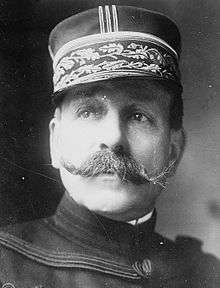Augustin Dubail
| Augustin Dubail | |
|---|---|
 General Dubail wearing his “Kepi over one eye with the chic exquis (exquisite chic) of the Second Empire”.[1] | |
| Born |
15 April 1851 Belfort, France |
| Died |
7 January 1934 (aged 82) Paris, France |
| Allegiance |
|
| Years of service | 1870–1916 |
| Rank | General de Division |
| Commands held |
14th Infantry Division 9th Army Corps First Army (France) Army Group East |
| Battles/wars |
Franco-Prussian War World War I |
| Awards |
Grand cross of the Légion d'honneur Médaille militaire |
Augustin Yvon Edmond Dubail (15 April 1851 – 7 January 1934) was a French Army general. He commanded the First Army and Army Group East during World War I.
Biography
Augustin Dubail[2] graduated from the military school of Saint-Cyr in 1870 and was commissioned an officer in the infantry. During the Franco-Prussian War Dubail fought at Saarbrücken, Spicheren, Borny before being captured at Metz. After the war Dubail served as a professor at Saint-Cyr, as an officer on the border and in Algeria, where in 1901 he became colonel of the 3rd Zouaves.
In 1904–1905 Dubail served twice as chief of staff of the French Minister of War Maurice Berteaux. Promoted to brigadier general, Dubail commanded the 53rd Infantry Brigade, the 5th Infantry Brigade and the 14th Infantry Brigade and was commandant of Saint-Cyr (1906–1908) before being appointed to the technical committee of the infantry.
During the Agadir Crisis in 1911 Dubail was Chief of Staff of the Army, reporting to the new War Minister, Adolphe Messimy. Messimy and Dubail tried to have the Army adopt 105mm heavy guns, but French generals saw them as a drag on the offensive (preferring to use the lighter and more mobile "Soixante-Quinze" gun) and better used as a defensive weapon like machine guns, so only a few were in use by 1914.[3] General Victor Michel, Vice-President of the Supreme War Council and commander-in-chief designate, later claimed that Dubail had privately agreed with his plans to deploy reservists in the front line and to adopt a more defensive war plan; however Michel had to resign when no senior general backed him.[4] Dubail's post was abolished in Messimy's reforms.[5]
In 1912 Dubail was given command of the IX Corps and in 1914 he became a member of the Supreme War Council.
When the war broke out Dubail was given command of the First Army, which would start the invasion of Germany by taking Lorraine together with de Castelnau’s Second Army. The armies met strong German resistance and were repulsed out of Lorraine with heavy casualties. They were able to reform and defend the French border against a German attack.
In 1915 he was promoted to commander of Army Group East on the Western Front, around Belfort and Verdun. He became convinced that a major German offensive was coming against Verdun. He called for reinforcements and heavy artillery and the new Allie tanks for the Verdun sector, but the French commander-in-chief, Joseph Joffre, wasn’t convinced that an attack was imminent.
When the German offensive began at Verdun, Joffre partly blamed Dubail, who was fired in March 1916, publicly humiliated. He claimed to have been made a scapegoat for Joffre’s lack of foresight, although he had himself public played down the likelihood of a German attack at Verdun. Dubail was hired again and became military governor of Paris, a position he kept until the spring 1918, when he retired from public life. Dubail died in 1934, aged 82.
Decorations
- Légion d'honneur
- Knight (24 June 1886)
- Officer (11 July 1900)
- Commander (30 December 1905)
- Grand Officer (30 December 1911)
- Grand Cross (18 September 1914)
- Médaille militaire (8 October 1915)
- Croix de guerre 1914–1918 with 1 palm
- Médaille Interalliée de la Victoire
- Médaille Commémorative de la Guerre 70–71
- Médaille Commémorative de la Grande Guerre
- Croix de guerre (Belgian)
- Distinguished Service Medal (US)
- Honorary Knight Grand Cross of the Order of St Michael and St George (UK)
- Officer of Nichan Iftikhar (Tunisia)
References
- ↑ Tuchman 1962, p.46-7
- ↑ Dubail was named Augustin Yvon Edmond at birth. See online Base Léonore quoted below.
- ↑ Tuchman 1962, p. 230
- ↑ Tuchman 1962, p.46-7
- ↑ Tuchman 1962, p. 48-9 The job was merged with that of Vice-President of the Supreme War Council to create a new enhanced post of Chief of the General Staff; the generals considered for the post - Joseph Joffre (who was appointed), Joseph Gallieni and Paul Pau - were all senior to Dubail
- David F. Burg & L. Edward Purcell, Almanac of World War I, The University Press of Kentucky, 1998.
- Christopher Clark, The Sleepwalkers: How Europe Went to War in 1914, Allen Lane, Penguin, 2012.
- Tuchman, Barbara (1962). The Guns of August. Random House. ISBN 978-0345476098..
- Biography of Augustin Dubail.
- Base Léonore for his records concerning the Légion d'honneur (French decoration).
| Wikimedia Commons has media related to Auguste Dubail. |